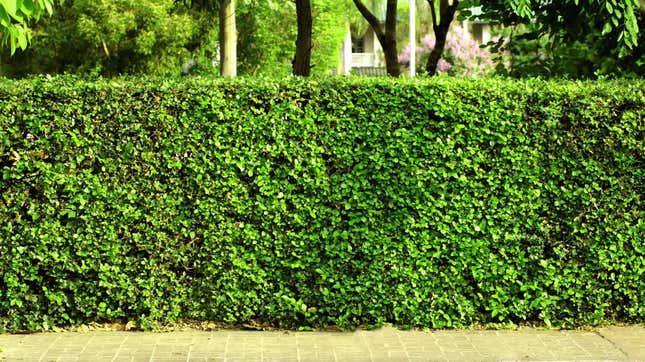Living Fences: A Practical Guide To Design, Planting, And Care

Table of Contents
Designing Your Living Fence
Before you even think about planting, careful planning is key to a successful living fence. This involves selecting the right plants, planning the layout, and preparing the site.
Choosing the Right Plants
Selecting appropriate plants is crucial for the success of your living fence. Consider your climate, soil type, desired height and density, and aesthetic preferences.
- Fast-growing vs. slow-growing: Fast-growing options like Privet (Ligustrum) offer quick results, while slower-growing plants like Hawthorn (Crataegus) provide a more refined, long-term structure.
- Evergreen vs. deciduous: Evergreen plants provide year-round screening and visual interest, while deciduous varieties offer seasonal color changes and may require less pruning.
- Thorny varieties for security: Consider thorny plants like Berberis (barberry) or Pyracantha (firethorn) if security is a primary concern.
- Drought-tolerant species: For drier climates, choose drought-tolerant options to minimize watering needs. Consider native plants adapted to your region.
- Local native plants: Prioritize locally sourced native plants to maximize biodiversity and support local ecosystems. They are often better adapted to the local climate and require less maintenance.
Planning the Layout and Structure
Determine the fence's length, desired width, and overall shape. Consider existing landscape features and access points.
- Straight lines or curves: Straight lines provide a formal look, while curved designs can soften the landscape and follow natural contours.
- Incorporating existing features: Integrate your living fence with existing trees or structures for a more cohesive design.
- Support structures: For initial establishment, especially with taller plants, use support structures like posts and wires to keep the young plants upright and properly spaced.
- Adequate spacing: Allow ample space between plants for healthy growth. Overcrowding can lead to competition for resources and reduced vigor.
Considering Site Preparation
Proper soil preparation is essential for optimal plant establishment and long-term health.
- Soil testing: Conduct a soil test to determine its pH and nutrient content. Amend the soil as needed to create an ideal growing environment.
- Soil amendment: Incorporate compost or other organic matter to improve soil structure, drainage, and fertility.
- Weed removal: Thoroughly remove existing weeds and grass before planting to minimize competition.
- Drainage: Address any drainage issues to prevent waterlogging, which can damage plant roots.
Planting Your Living Fence
Once your design and site preparation are complete, it's time to plant your living fence.
Selecting and Acquiring Plants
Source healthy, high-quality plants from reputable local nurseries.
- Plant size: Choose appropriately sized plants for your design. Larger plants establish quicker but are more expensive.
- Disease and pest checks: Carefully inspect plants for signs of disease or pests before purchasing.
- Bare-root vs. container plants: Bare-root plants are generally cheaper but require more careful handling during planting. Container plants are easier to handle but can be more costly. Locally sourced plants are often a better choice.
The Planting Process
Follow proper planting techniques to ensure successful establishment.
- Digging holes: Dig holes slightly larger than the root ball or bare root spread.
- Handling root systems: Carefully handle the root systems to avoid damage. Gently loosen any circling roots.
- Deep watering: Water deeply after planting to settle the soil around the roots.
- Mulching: Apply a layer of mulch to retain moisture, suppress weeds, and moderate soil temperature.
Initial Maintenance
Provide the necessary care during the crucial initial growth phase.
- Regular watering: Water regularly, especially during dry periods, until the plants are established.
- Weed control: Remove weeds regularly to prevent competition for resources.
- Pest and disease protection: Monitor plants for pests and diseases and take action promptly if problems arise. Protective barriers may be needed for young plants.
Ongoing Care for Your Living Fence
Maintaining your living fence involves regular watering, fertilizing, pruning, and pest and disease management.
Watering and Fertilizing
Maintain adequate moisture levels and provide essential nutrients.
- Watering frequency: Adjust watering frequency based on weather conditions and plant needs. Consistent watering is crucial, especially during dry spells.
- Fertilizing: Use organic fertilizers to promote healthy growth. Follow the fertilizer instructions carefully.
Pruning and Shaping
Regular pruning is essential for maintaining the shape, density, and overall health of your living fence.
- Pruning techniques: Use appropriate pruning techniques for your chosen plant species. Learn which methods are best for each type of plant.
- Removing dead branches: Remove dead, diseased, or damaged branches promptly.
- Maintaining shape and size: Prune to maintain the desired height and width of your fence.
Pest and Disease Management
Address potential issues promptly to prevent widespread damage.
- Identification: Learn to identify common pests and diseases affecting your chosen plant species.
- Prevention: Implement preventative measures such as proper watering, fertilization, and spacing to minimize risks.
- Organic pest control: Use organic pest control methods whenever possible.
Conclusion
Living fences offer a beautiful, sustainable, and practical alternative to traditional fences. By carefully planning your design, following proper planting techniques, and providing consistent care, you can create a thriving living fence that enhances your property's aesthetic appeal, provides privacy and security, and supports local wildlife. Start planning your own living fence today and enjoy the long-term benefits of this environmentally friendly landscaping choice. Learn more about creating your own beautiful and functional living fences by researching different plant options and best practices. Invest in a thriving, natural living fence and reap the rewards!

Featured Posts
-
 Why Winning Riders Choose Honda Motorcycles
May 29, 2025
Why Winning Riders Choose Honda Motorcycles
May 29, 2025 -
 Investigation Launched Into Antisemitism Claims At Queensland Music Awards
May 29, 2025
Investigation Launched Into Antisemitism Claims At Queensland Music Awards
May 29, 2025 -
 Antqal Jwnathan Tah Ila Bayrn Mywnkh Kl Ma Nerfh
May 29, 2025
Antqal Jwnathan Tah Ila Bayrn Mywnkh Kl Ma Nerfh
May 29, 2025 -
 Van Egy Regi Nokia Telefonod Lehet Hogy Toebbet Er Mint Gondolnad
May 29, 2025
Van Egy Regi Nokia Telefonod Lehet Hogy Toebbet Er Mint Gondolnad
May 29, 2025 -
 Oslo Brann Nyhetsvarsel Om Fire Odelagte Bater
May 29, 2025
Oslo Brann Nyhetsvarsel Om Fire Odelagte Bater
May 29, 2025
